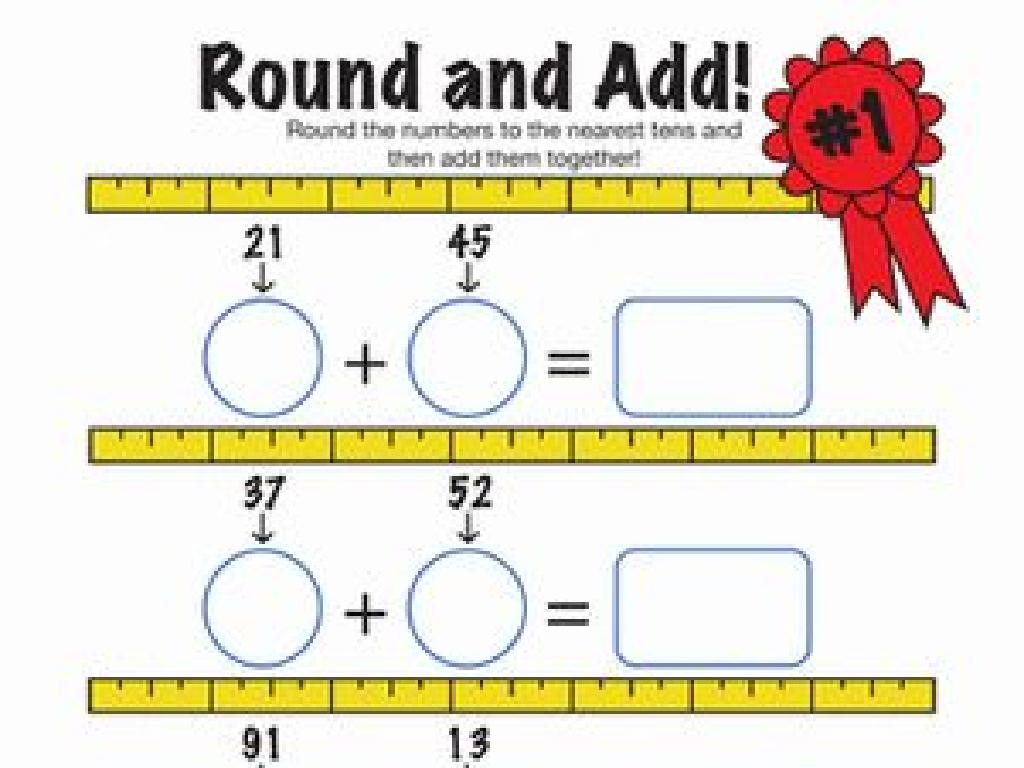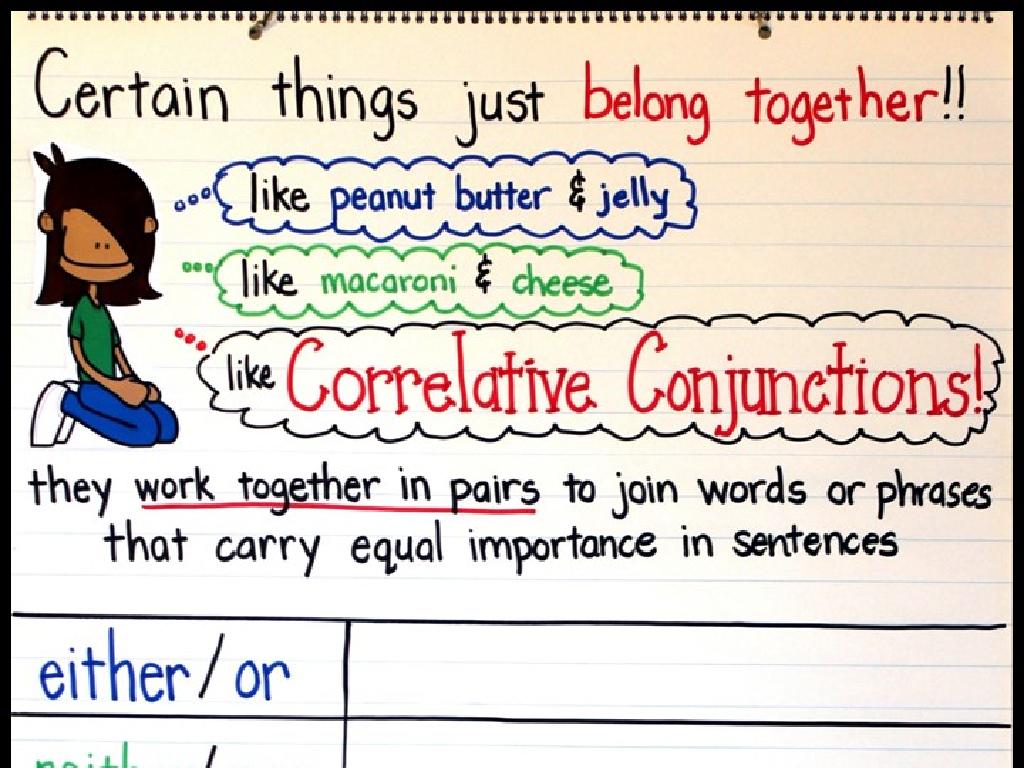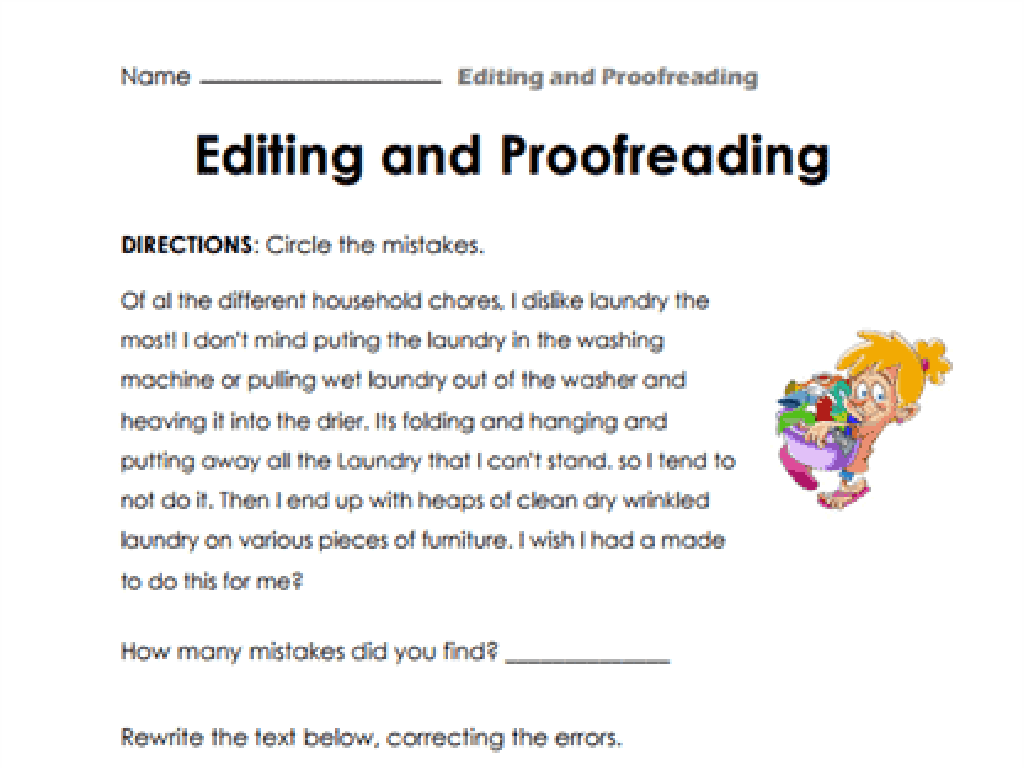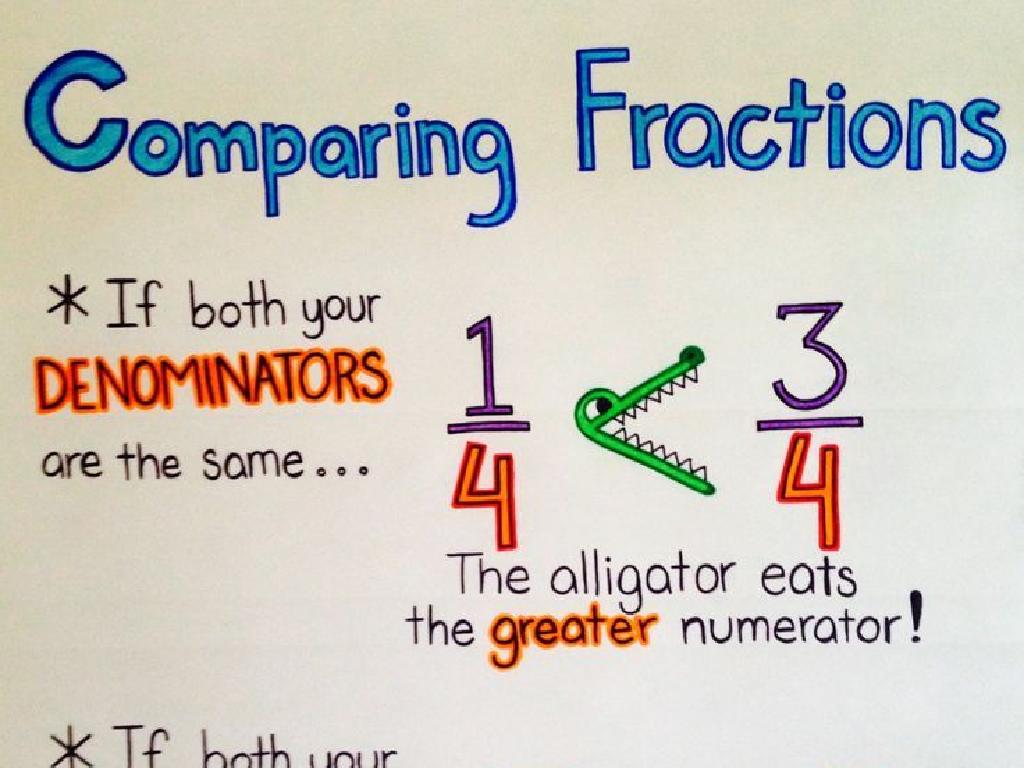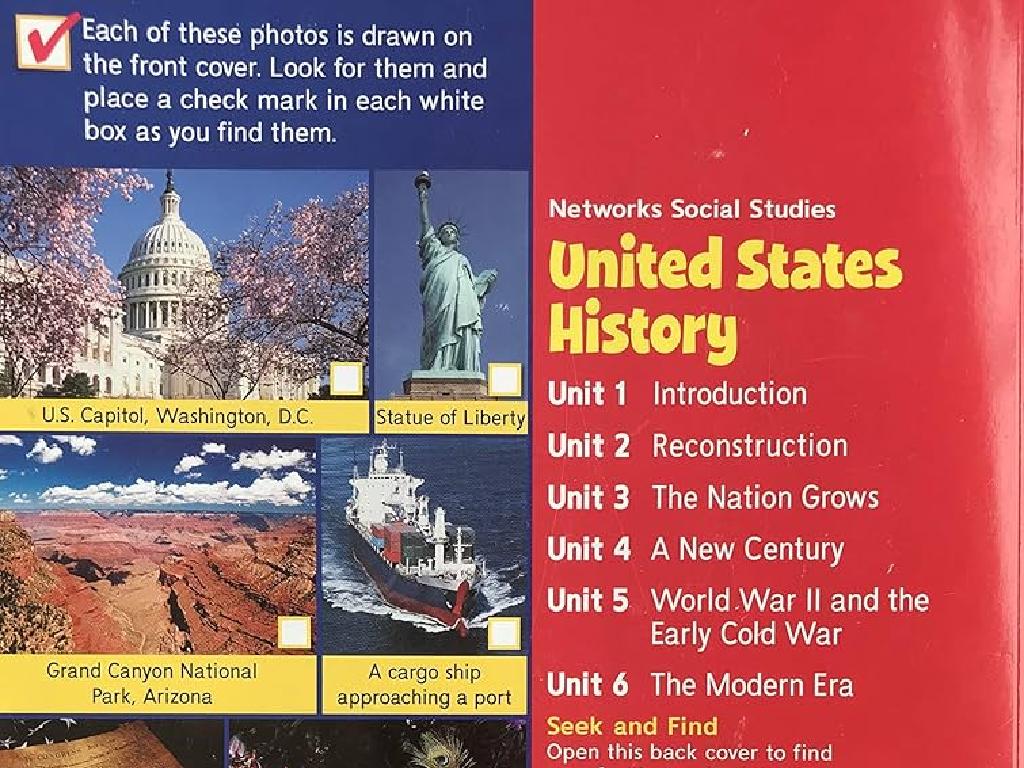Adding 3
Subject: Math
Grade: First grade
Topic: Addition Up To 20
Please LOG IN to download the presentation. Access is available to registered users only.
View More Content
Welcome to Addition: Adding 3
– Greet our bright young learners
– Today’s focus: Adding 3 to numbers
– Understand the concept of addition
– Addition combines two amounts into a total
– Practice adding 3 with examples
– Example: If you have 2 apples and get 3 more, how many do you have now?
|
This slide is designed to introduce first graders to the concept of addition, with a focus on adding the number 3. Start the class with a warm greeting to create a welcoming atmosphere. Explain that addition is a way of finding out how much you have in total when you put groups of things together. Use tangible examples like combining fruits or toys to illustrate the point. Encourage the students to think of addition as ‘putting together’ and ‘adding on.’ Provide simple examples of adding 3 to different numbers within 20 and use visual aids like counters or fingers to help them understand. The goal is to make them comfortable with the idea of addition as a basic arithmetic operation.
What is Addition?
– Addition means putting together
– It’s like combining toy groups
– Imagine you have 2 teddies and 3 cars
– Find out the total number
– Example: 2 toys + 3 toys
– How many toys do you have now?
|
This slide introduces the concept of addition to first graders by relating it to a familiar activity – playing with toys. Start by explaining that addition is a way of finding out how many items there are in total when two groups are combined. Use tangible examples like toys to make the concept relatable. For instance, if a student has 2 teddy bears and then gets 3 toy cars, they can physically combine these groups and count the total, which helps them understand the concept of addition. Encourage the students to think of their own examples of adding groups of items. This will help them grasp the idea of addition as a method of combining quantities to find a new total.
Adding 3 to Numbers
– Adding 3 means jumping forward
– Let’s try with number 1
– Start at 1 on our number line
– Jump three spaces on the number line
– One, two, three; we hop to the right
– Where do we land? On number 4!
– After three big jumps, we reach 4
|
This slide introduces the concept of addition by 3 using a number line, which is a visual tool that helps students understand the process of counting forward. Start by explaining that adding 3 is like taking three steps forward from any number. Use the example of 1 + 3 to show this process in action. Have the students physically mimic jumping three spaces forward to reinforce the concept. Encourage them to use their fingers to count or to visualize the jumps on a number line. After explaining, ask the students to try with different numbers, such as 2 + 3, 3 + 3, and so on, to practice the concept of adding 3.
Let’s Practice Adding 3!
– Counting on from 2: What’s 2 + 3?
– Let’s count: 2…3, 4, 5. So, 2 + 3 is 5!
– Adding to 4: Find 4 + 3 using fingers
– Hold up 4 fingers, now add 3 more fingers. Count: 5, 6, 7!
– Visualize 3 jumps forward from a number
– Imagine hopping 3 steps from any number. Try with 6: hop to 7, 8, 9!
– Practice makes perfect with adding 3
|
This slide is an interactive activity to help first graders practice the concept of adding 3 to different numbers. Start by counting together from 2 to add 3, ensuring the students understand the concept of counting on. Then, move to using fingers to add 3 to 4, which provides a tactile learning experience. Emphasize the idea of ‘three little jumps forward’ to help them visualize the addition process. Encourage students to practice with different numbers and to share their answers with the class. This will help solidify their understanding of addition and prepare them for more complex problems.
Adding 3 with Objects: Apples
– Start with 5 apples
– Add 3 more apples
– Now, let’s count all the apples
– After adding, we count 5…6, 7, 8 in total
– How many apples do we have?
– Understanding addition by using objects
|
This slide is designed to help first graders visualize the concept of addition by using a familiar object – apples. Start by asking the students to imagine having 5 apples and then receiving 3 more. Use the slide to guide them through drawing 5 apples, adding 3 more, and then counting all the apples together. This concrete example helps them grasp the abstract concept of addition. Encourage the students to draw along with you and to count out loud as a group. Reinforce the idea that addition is simply ‘putting together’ and counting the total. After the exercise, ask the students how many apples they have to ensure they’ve understood the concept of adding 3.
Adding 3 with Birds on a Tree
– Start with 6 birds on a tree
– 3 more birds come to join
– Let’s draw all the birds
– Drawing helps us see the addition
– Now, let’s count them together!
– Counting confirms our total is 9
|
This slide introduces the concept of addition by incorporating it into a story that is easy for first graders to understand and visualize. Start by describing the scenario with 6 birds on a tree. Then, introduce the idea that 3 more birds have joined them on the branch. Encourage the students to draw the birds on the tree, which will help them visualize the addition process. After drawing, guide the students to count all the birds together, reinforcing the concept that 6 birds plus 3 more birds equal 9 birds in total. This activity combines visual learning with counting to solidify the students’ understanding of adding 3.
Game Time: Adding 3 with Dice!
– Roll the dice for a number
– Add 3 to your dice number
– If you roll a 4, what is 4 + 3?
– Practice makes perfect
– Have fun learning addition!
|
This interactive game is designed to help first graders practice the concept of adding 3 to numbers up to 20. By using dice, students can engage in a hands-on activity that makes learning addition fun. Teachers should guide students through the process of rolling the dice, adding 3 to the number rolled, and then confirming the correct sum. Encourage students to repeat the process multiple times for practice. Possible variations of the activity could include pairing students to take turns, using different colored dice for competitive games, or challenging students to reach a certain sum before their peers.
Class Activity: Addition Art
– Draw something you like
– Add 3 more of the same item
– Count your total items
– Share with the class
– Explain how many you have now
|
This activity is designed to make learning addition fun by incorporating art. Students will draw an item of their choice and then draw three more of the same item. Afterward, they will count all the items together to practice adding 3. This helps them visualize the concept of addition. Teachers should prepare to assist students who may struggle with drawing or counting. Possible variations of the activity could include using stickers, stamps, or cut-out shapes instead of drawing. Encourage students to be creative and ensure they understand that the focus is on the addition, not artistic skills. After completing their art, each student will present their total count to the class, reinforcing their understanding and building their confidence in speaking and mathematics.
Review and Goodbye: Adding 3
– Recap: What is adding 3?
– Adding 3 means putting 3 more to a number.
– Example: Adding 3 to 7
– Who can tell us what 7 plus 3 is?
– Praise for today’s work
– Practice adding 3 at home
– Try with different numbers and use objects like toys to count.
|
This slide is meant to wrap up the lesson on adding 3. Start by asking the class to summarize what they’ve learned about adding 3 to various numbers. Then, move on to a quick interactive example by asking a volunteer to demonstrate adding 3 to the number 7. Offer praise to the entire class for their hard work and encourage them to continue practicing at home. Suggest that they use physical objects like toys or fingers to help them visualize the concept of adding 3. This will help reinforce today’s lesson and build their confidence in their addition skills.

